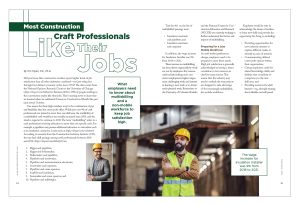Most Construction Craft Professionals Like Their Jobs
Did you know that construction workers report higher levels of job satisfaction than all other industries combined—not just today, but through four distinct economic cycles since 1974?! The data comes from the National Opinion Research Center at the University of Chicago (https://tinyurl.com/y3bmktyy). Between 86% to 89% of people working in the construction trades like their jobs. That’s exciting news to share that we learned when we celebrated Careers in Construction Month this past (and every) October.
One reason for these high numbers may be the combination of pay and flexibility that this career path offers. While just over 9% of craft professionals are trained in more than one skill area, the availability of a multiskilled craft workforce has steadily increased since 2005, and the trend is expected to continue to 2030. The term “multiskilling” refers to a craft professional receiving education in more than one specific craft. For example, a pipefitter may pursue additional education in curriculum such as an insulation contractor. Learn more at https://tinyurl.com/mrtvubjk. According to research from the Construction Industry Institute (CII), the top dual-skill pairings among craft professionals between 2005 and 2019 (https://tinyurl.com/bd2dstj4) are:
- Rigger and pipefitter,
- Rigger and boilermaker,
- Boilermaker and pipefitter,
- Pipefitter and ironworker,
- Pipefitter and instrumentation electrician,
- Ironworker and carpenter,
- Pipefitter and crane operator,
- Scaffold and insulation,
- Ironworker and crane operator, and
- Pipefitter and millwright.
Tied for #11 on the list of multiskilled pairings were:
- Insulation mechanic and pipefitter, and
- Insulation mechanic and carpenter
In addition, the wage increase for Insulation Installer was 9% from 2018 to 2021.
These increase in multiskilling has been driven organically by workers, not by employers. Key reasons cited include seeking more consistent employment, higher wages, more challenging work, and interest in learning a new trade or to obtain easier physical work. Researchers at the University of Colorado-Boulder and the National Center for Construction Education and Research (NCCER) are currently working to further understand the factors and impacts of multiskilling.
Preparing for a Less Mobile Workforce
As craft worker preferences change, employers need to be prepared to meet those needs. High job satisfaction is generally acknowledged as having a direct correlation to low turnover, as cited by many sources. This means that the industry may need to rethink the way projects are designed to take advantage of the increasingly multiskilled, less mobile workforce.
Employers would be wise to acknowledge the desire of workers to learn new skills and provide the opportunity for doing so, including:
- Providing opportunities for new industry entrants to explore different trades to identify an area of interest;
- Communicating defined career path options within their organization;
- Giving employees credit for related knowledge, skills, and abilities that contribute to competency in the new skill area; and
- Providing resources for adult learners—e.g., through training that is flexible and self-paced.
Additional CCI research findings indicate the most important workforce development element is a firm’s formal policy for or commitment to providing a formal craft skills training program. Interestingly, the contractors, owners and other training professionals who participated in the study had the same perception towards the relative importance of workforce development elements. Read the Construction Productivity Research Program at https://tinyurl.com/yc4rpdu5.
Related to this observation, the growing preference by an increasing percentage of craft professionals is to remain in one geographic location, rather than traveling for work. At the same time, spousal employment within the industry has grown to above 80%. Together, these factors point to reduced mobility among the craft workforce—a trend that is likely to intensify in coming years. Visit https://tinyurl.com/yc58em8d to read Workforce 2030: What You Need to Know Now About Your Future Workforce.
Videos available at https://tinyurl.com/8td8y5am provide additional insight into the multiskilled
workforce.
Careers in Construction Month
Careers in Construction Month is a nationwide campaign held every October to increase public awareness of construction careers, inspire the next generation of craft professionals, and make an impact on the perceptions of a career in construction. Your company can continue promoting careers in the insulation industry all year long! Discover resources that might assist you at www.byf.org and www.insulation.org.

